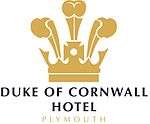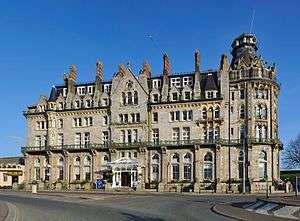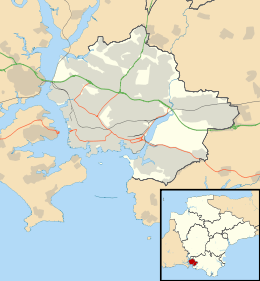Duke of Cornwall Hotel
| Duke of Cornwall Hotel | |
|---|---|
 | |
 | |
| General information | |
| Location | Plymouth, Devon, England |
| Coordinates | 50°22′04″N 4°09′00″W / 50.3677001°N 4.1499031°WCoordinates: 50°22′04″N 4°09′00″W / 50.3677001°N 4.1499031°W |
| Opening | 1865[1] |
| Owner | Plymouth Hotel Company |
| Design and construction | |
| Architect | C. Forster Hayward[1] |
| Other information | |
| Number of rooms | 72 |
| Number of restaurants | 1 |
| Parking | Available |
| Website | |
| http://www.thedukeofcornwall.co.uk | |
 Duke of Cornwall Hotel Duke of Cornwall Hotel (Plymouth) | |
The Duke of Cornwall Hotel is a hotel in the city of Plymouth, Devon, England. Built in Victorian Gothic style, it opened in 1865 to cater for the increasing number of travellers who were coming to the region by rail and sea.
The hotel survived the World War II Plymouth Blitz without damage, and was the venue for regular functions throughout the war, even though the family that ran it were members of the fascist party and were removed from the city in 1944. In the 1970s and early 1980s it was threatened with closure but, helped by poet laureate John Betjeman's praise for its architecture, it was saved by a major refurbishment. Today it is considered to be one of Plymouth's principal landmarks.[2]
History

The first steam train arrived at Plymouth Millbay railway station (now closed) on 2 April 1849. The increase of first class travel to the area led to an increasing demand for luxury accommodation and once the need for a quality hotel was recognised, a group of railway directors were appointed as the hotel's board of directors. They selected the architect C. Forster Hayward,[3] who later designed the Swyddfa'r Sir in Aberystwyth to the same style but on a smaller scale.[4] The builders were "Honest" John Pethick and Benjamin Call,[5] who had already completed several jobs for the South Devon Railway Company including the rebuilding of Exeter St Thomas railway station and Newton Abbot and a hotel in Old Town Street of the city.
Construction started in 1863 and the hotel opened in 1865.[1] Five different types of stone were used to create the building in Victorian Gothic style. Owned by the Plymouth Hotel Company the Duke of Cornwall cost £40,000 to develop including the excavation work required to clear the site where the Saracens Head Public House and Millbay Grove Terrace once stood.[6]
The 1920s
In the 1920s long distance road travel was becoming a viable option and during the same period the number of ocean liner visits to Plymouth had doubled from 350 to 700 a year. Plymouth's location was attractive as it could cut a whole day in getting back to London by train rather than being routed through Southampton. With this spare day the people were looking for accommodation and due to this increase in passing trade the hotel went through a thorough program of reconstruction and redecoration. Its lighting was electrified, a lift was installed, and the sanitary arrangements were certified by the local authority.
The 1930s
During the 1930s Millbay dock grew in popularity due to its ocean going status. In this period many celebrities visited Plymouth including Walt Disney, Charlie Chaplin, Duke Ellington and Bing Crosby. The number of liner visits peaked during the 1930s and the city looked to promote itself as a tourist destination. 1934 saw the memorial for the Mayflower Steps officially open. This was to promote the Pilgrim Fathers link with America. The following year the Tinside Lido opened on the Hoe.
World War II
On 6 July 1940 the first air raid of the Plymouth Blitz[7] took place and local people were aware of the city of Plymouth’s importance to the enemy. With the large HMNB Devonport Naval base nearby, it was inevitable that this base would soon become a target. Over the next four years there were 59 separate assaults on the city. Thousands of homes and businesses were destroyed during that time making Plymouth one of the most bombed cities in the country.
Despite the bombing, the Duke of Cornwall hotel survived relatively unscathed, unlike the St James the Less Church and the Millbay railway station which stood either side of the hotel. Thanks to this dances took place in the ballroom every Wednesday and Saturday nights.[6] They proved to be a welcome break from the pressure and fear that had become part of everyone’s lives. American troops and local people alike attended these functions and wedding receptions were also held in the hotel. Guests were entertained by the likes of Anne Ziegler and Webster Booth and other artistes who were staying at the hotel whilst playing at the nearby Palace Theatre on Union Street.
According to the intelligence records of the MI5 and home office reports, the Welsh family that ran the hotel during the war had strong ties to the fascist party and was suspected by MI5 of gathering military intelligence from naval personnel. In particular, the manager's daughter-in-law was accused of taking American servicemen to her bedroom where she would coax sensitive military information from them after 'entertaining' them. On 10 February 1944 Mrs Welsh and her daughter-in-law Bebe were placed on the suspects list. In March she and her husband had a restriction order which prohibited their presence in an aliens protected area. They had been watched from at least 1939 but it was not until 1944 that they were forced to leave before the Allied invasion of France in the spring of 1944, MI5 recommended their detention.[8][9][10]
Famous guests
In August 1914 Ernest Shackleton stayed in the hotel the night before his Imperial Trans-Antarctic Expedition. Other names in the visitors book include Tommy Trinder, Anne Ziegler and Webster Booth. In 1954 Laurel and Hardy were due to perform in the Palace Theatre on 17 May, but were forced to cancel the show due to Oliver Hardy suffering from flu and a mild heart attack.[11] Due to the train station opposite, the hotel benefited from various other celebrities including Charlie Chaplin who would take the train from London then sail back to New York City from the docks at Mill bay.[12] More recently Suzi Quatro, Hale and Pace, Cameron Mackintosh, Lionel Blair, Alan Clarke and Dame Janet Fookes all have their names signed in the visitors book.
Threat of closure and refurbishment
The building was listed as Grade II in 1975,[13] despite which it faced threats of closure in 1977. A local newspaper article read: "Plymouth’s 114 year old Duke of Cornwall Hotel which kept the tourism flag flying in Queen Victoria’s days and defied the wrath of Hitler’s bombs, is in danger of being pulled down".[14] This was due to the lack of car parking space: the terraced gardens gave way to a new car park in 1988. In 1987 another article reported "Plymouth’s last grand Victorian Hotel is up for sale".[15]
The hotel was described by Sir John Betjeman as "one of the finest examples of Victorian gothic architecture he had ever seen", and in 1988 its future was secured.[16] A refurbishment programme affecting almost every area of the building was completed. The ballroom was completely refurbished in 1994 and the old Spider’s Web bar converted to a new function suite – the Fleur de Lys suite.
Facilities and accreditations
The Duke of Cornwall has 72 rooms and suites including the Tower Room that gives a 270 degree view of the city, coast and countryside.[6] The hotel is regularly used as a venue for weddings, conferences and various functions. It is within walking distance of shopping streets, Theatre Royal, Plymouth University and Plymouth Pavilions as well as popular historical sites including the Hoe, Barbican, Mayflower Steps and Plymouth Gin Distillery.[17]
Today the Duke of Cornwall remains one of Plymouth’s most famous landmarks.[2] Its restaurant dining room has been described by Frommer's as "one of the finest in the area", and describes the setting as "elegant".[18] The hotel has three stars and one red rosette from the AA.[19]
References
- 1 2 3 Pevsner, Nikolaus (1989) [1952]. Cherry, Bridget, ed. The Buildings of England: Devon. Harmondsworth: Penguin Books. p. 665. ISBN 0-14-071050-7.
- 1 2 "Duke of Cornwall Hotel – Plymouth, United Kingdom". Yahoo! Travel. Retrieved 5 February 2011.
- ↑ "1863 – Duke of Cornwall Hotel, Plymouth, Devon". archiseek. Retrieved 5 February 2011.
- ↑ "Swyddfa'r Sir". Coeflein. Retrieved December 2014. Check date values in:
|access-date=(help) - ↑ "Plymouth, John Pethick". The Duke of Cornwall. Retrieved December 2014. Check date values in:
|access-date=(help) - 1 2 3 Duke of Cornwall Hotel website
- ↑ Gill, Crispin (1993). Plymouth. A New History. Devon Books. pp. 259–262. ISBN 0-86114-882-7
- ↑ Gray, Todd (2006). Blackshirts in Devon. The Mint Press. pp. 271–275. ISBN 978-1-903356-46-3
- ↑ Spiers, Judi. "Fascists and Pasties". Devon Life. Retrieved 5 February 2011.
- ↑ "Shocking history". Western Morning News (Plymouth). 6 January 2007. Retrieved 5 February 2011. (Subscription required)
- ↑ "Laurel and Hardy at the Palace Theatre". plymouthlocalhistory. Retrieved 17 December 2014.
- ↑ "Charlie Chaplin at the Duke of Cornwall". plymouthherald. Retrieved 17 December 2014.
- ↑ "Detailed Record". English Heritage. Retrieved 5 February 2011.
- ↑ The Herald (Plymouth), Plymouth, 12 September 1977.
- ↑ The Herald (Plymouth), Plymouth, 16 March 1987.
- ↑ The Herald (Plymouth), Plymouth, 26 February 1988.
- ↑ "Duke of Cornwall Hotel, an Hotel in Plymouth, Devon". www.information-britain.co.uk. Retrieved 5 February 2011.
- ↑ "Duke of Cornwall Hotel". Frommer's. Retrieved 20 September 2010
- ↑ "Duke of Cornwall Hotel – Plymouth". The Automobile Association. Retrieved 5 February 2011.
